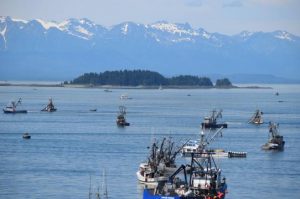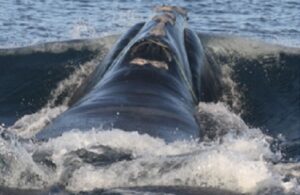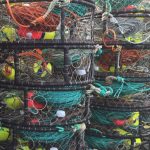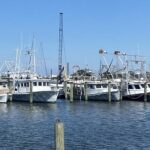Tag Archives: gray seals
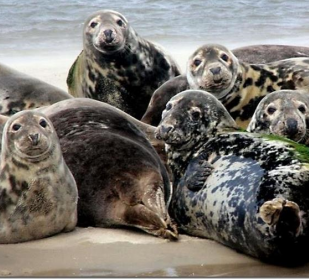
Great white sharks not the only threat gray seals bring – Here’s Why.
Over the winter, gray seals have — thanks in large measure to the protection afforded by the Marine Mammal Protection Act — further augmented their numbers. The “gray seal buffet” is once again open for business. But this season is, of course, unlike any in recent times. For the Cape and Islands, the coronavirus poses a far greater threat to the safety of its beachgoers and well-being of its economy than white sharks. But those threats are not necessarily unrelated. Here’s why. The Marine Mammal Protection Act is distinctive in that it not only protects all marine mammals, it protects them in perpetuity, regardless of their numbers and impact on co-existing species, including humans. Let me hasten to acknowledge that the act was necessary and appropriate when it was passed almost 50 years ago and remains so in most respects. Because it protects marine mammals permanently, it in effect relies on nature to take its course in controlling marine mammal populations and finding an appropriate balance among competing and coexisting marine species. >click to read< 09:06
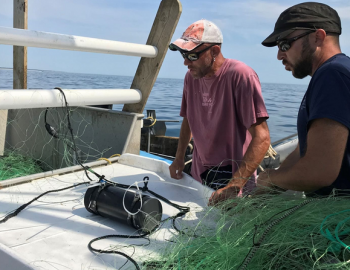
The costs of depredation: Underwater Cameras Tackle Tough Questions for Fishery
Scientists at the Woods Hole Oceanographic Institution (WHOI) and the Center for Coastal Studies (CCS) are working with local fishermen on Cape Cod to understand exactly what happens when seals and other marine mammals invade a fishing net to forage.,,, The costs of depredation—when marine animals prey on fish caught in nets—can be high on both fronts. On the economic side, it can reduce the amount of sell-able fish and lead to torn fishing nets. “A five-inch opening in the net can quickly become a 15-inch hole when a seal gets caught and tries to free itself,” said Doug Feeney, a commercial fisherman based in Chatham, Massachusetts. >click to read< 12:30

Protecting gray seals — when does success become excess?
The ever-expanding gray seal population in our coastal waters is protected in perpetuity by the Marine Mammal Protection Act of 1972. The success of the act in restoring gray seal populations is widely acknowledged, but at what point should we address the problematic consequences of that success? With numbers of white sharks — attracted by gray seals — being spotted off our beaches, answering that question is becoming increasingly urgent. >click to read< 17:50
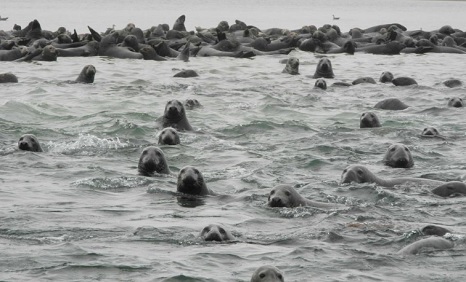
Sharks and seals: A success story ?
With five shark attacks on people since 2012 — including swimmers, kayakers, a paddleboarder and a fatal attack on a bodyboarder last year — surfers, swimmers, public safety officials and business owners now worry that the ocean is suddenly not safe. Some see an imbalance that requires corrective measures, like a cull of seals and maybe sharks to reduce risk and bolster fish harvests. But others marvel at a pair of conservation success stories in an era where species extinction is more often the news. >click to read<23:54
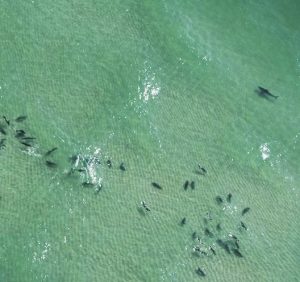
White sharks aren’t the issue. Gray seals are – amend the 1972 Marine Mammal Protection Act
Last summer’s white shark attacks off Cape Cod beaches, one resulting in the first human fatality in the state in over 80 years, highlight the fact that times change, our marine ecosystem is evolving, and laws need to adjust to these changing realities. However tragic those shark attacks are for the victims and their families, the white sharks are not the issue; they simply dramatize it. The ever-increasing population of gray seals is the issue.,, A realistic start to addressing this issue would be to amend the 1972 Marine Mammal Protection Act to provide for delisting recovered species, such as the gray seal. Admittedly, while delisting would not resolve the issues of controlling seal population growth or related white shark attacks, it would be a reasonable first step for the following reasons: >click to read<09:31

Seals were once nearly wiped out from the Gulf of Maine.
At any given time, approximately 600 seals splash, bathe and feed around a modest mass of rocks six miles off the coast of Maine, the northernmost of the Isles of Shoals. These seals, both gray and harbor species, have made a resurgence in local waters over the last two decades following the imperative enaction of federal protections. Prior to the 1970s, the species had essentially been extirpated in Maine and Massachusetts, after being hunted for their pelts, and killed as competition for fish, said Jennifer Seavey, executive director of Shoals Marine Laboratory on Appledore Island, a joint program between the University of New Hampshire and Cornell University. >click to read<09:38

The trade ban stays despite the growing seal populations – Only sealskin from Greenland can be traded in Finland.
The warm sealskin products are easy to sell in the cold conditions of the Arctic. The material would also be available in Finland, but, because of an EU ban against seal trade, only sealskin from Greenland can be traded. As winter embraces the north and cold spells hit the region, vendor Pekka Halonen starts his mobile shop and sets off to travel around Sápmi, the Land of the Sámi, in Finland and Norway. In 2009, the European Parliament decided that seal products could not be sold in or imported for sale into the European Union. click here to read the story 11:25
Gray seals are making a huge comeback on Cape Cod (where there are no longer any Cod!)
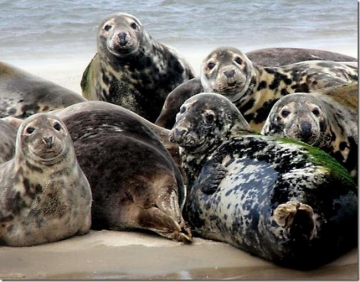 For nearly a hundred years, New England’s gray seals had a bounty on their heads. Maine and Massachusetts paid people to kill them, because they depleted fishing stocks. They were also hunted for their meat and pelts. By 1973—a year after the Marine Mammal Protection Act made it illegal to systematically kill the animals—a census estimated there were only 30 gray seals left along the entire coast of Maine. Since then, Canada’s gray seals have returned to recolonize the east coast of the U.S.,,, Now, in a study published in Bioscience, researchers have combined Google Earth images and data from tagged seals to make a more precise estimation of the population.,, “Our technology-aided aerial survey, which used Google Earth imagery in conjunction with telemetry data from tagged animals, suggests the number is much larger—between 30,000 and 50,000.” Not everyone is happy with the pinniped’s population explosion—particularly fisherman, who see them as competition for fish stocks. In recent years, some groups have advocated for culling the number of gray seals. Johnston says that not only would that be illegal, but it would also be premature. “We know almost nothing about what gray seals eat, how and where they forage,,, click here to read the story 10:48
For nearly a hundred years, New England’s gray seals had a bounty on their heads. Maine and Massachusetts paid people to kill them, because they depleted fishing stocks. They were also hunted for their meat and pelts. By 1973—a year after the Marine Mammal Protection Act made it illegal to systematically kill the animals—a census estimated there were only 30 gray seals left along the entire coast of Maine. Since then, Canada’s gray seals have returned to recolonize the east coast of the U.S.,,, Now, in a study published in Bioscience, researchers have combined Google Earth images and data from tagged seals to make a more precise estimation of the population.,, “Our technology-aided aerial survey, which used Google Earth imagery in conjunction with telemetry data from tagged animals, suggests the number is much larger—between 30,000 and 50,000.” Not everyone is happy with the pinniped’s population explosion—particularly fisherman, who see them as competition for fish stocks. In recent years, some groups have advocated for culling the number of gray seals. Johnston says that not only would that be illegal, but it would also be premature. “We know almost nothing about what gray seals eat, how and where they forage,,, click here to read the story 10:48
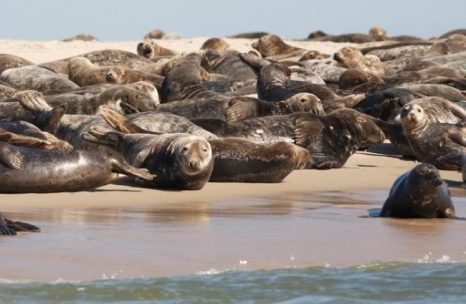
Cape Cod: Summing up the seals
When David Pierce seated himself at the table at the Nantucket Seal Symposium last month, one image came to mind: private pilot Aaron Knight’s video from last April showing miles of gray seals – a dozen deep, cheek by jowl, banding the Monomoy shoreline. Recently appointed as director of the state Division of Marine Fisheries, Pierce is a veteran of decades of fisheries negotiations as former director Paul Diodati’s proxy on the New England Fishery Management Council. Fishery managers live and die by population estimates, known as stock assessments, that help set sustainable catch levels for commercial fishermen, so it was disconcerting to hear that the same level of science had not been applied to the predators who eat them. “The determination of population size is extremely important, especially in the context of ecosystem management in New England,” Pierce said. “If they (gray seals) are out there in large numbers foraging, what might their impact be on the Georges Bank ecosystem?” The answer will not be coming any time soon, according to federal fisheries officials at the symposium. Read the story here 09:43
Cape Cod Gray seals’ impact comes into focus for students that quantified the numbers
 In April, Aaron Knight flew a small plane along the shore of South Monomoy Island off the Chatham coast, taking an aerial video of a seal-lined beach below him. Among the many who saw the film on Facebook was Peter Trull, field naturalist, author and a seventh-grade science teacher at Cape Cod Lighthouse Charter School in Harwich. Like everyone, he was amazed. One Facebook post quipped there appeared to be “trillions of seals.” Maybe not trillions, but the images did beg the question, how many? But one unanswered question, Trull said, is how many seals are there? “There’s no number,” he said. “There are estimates and some speculation, but no number.” In the aerial images, Trull saw an opportunity to find the answer. Trull has done many aerial counts of various species for NOAA, the Center for Coastal Studies, the U.S. Fish and Wildlife Service, and National Park Service. Trull combined his expertise with a lesson for his students. Read the rest here 17:21
In April, Aaron Knight flew a small plane along the shore of South Monomoy Island off the Chatham coast, taking an aerial video of a seal-lined beach below him. Among the many who saw the film on Facebook was Peter Trull, field naturalist, author and a seventh-grade science teacher at Cape Cod Lighthouse Charter School in Harwich. Like everyone, he was amazed. One Facebook post quipped there appeared to be “trillions of seals.” Maybe not trillions, but the images did beg the question, how many? But one unanswered question, Trull said, is how many seals are there? “There’s no number,” he said. “There are estimates and some speculation, but no number.” In the aerial images, Trull saw an opportunity to find the answer. Trull has done many aerial counts of various species for NOAA, the Center for Coastal Studies, the U.S. Fish and Wildlife Service, and National Park Service. Trull combined his expertise with a lesson for his students. Read the rest here 17:21
Cute Killers? Gray Seals Maul, Suffocate Seals and Porpoises, Studies Say
 It seemed a heart-warming sight: two seals apparently frolicking in the sea before slipping below the waves off the German island of Helgoland (map) in 2013. Then an ominous sheet of red unfurled across the waves. When the pair resurfaced, the bigger seal was skinning and eating its companion. “We thought they were playing,” says marine biologist Sebastian Fuhrmann , “It looked really cute, but in just a few seconds, it was over.” Read the rest here 19:29
It seemed a heart-warming sight: two seals apparently frolicking in the sea before slipping below the waves off the German island of Helgoland (map) in 2013. Then an ominous sheet of red unfurled across the waves. When the pair resurfaced, the bigger seal was skinning and eating its companion. “We thought they were playing,” says marine biologist Sebastian Fuhrmann , “It looked really cute, but in just a few seconds, it was over.” Read the rest here 19:29
As numbers of gray seals rise, so do conflicts
 Some residents of Nantucket are so fed up over the huge seal population that now calls the affluent island home that they have suggested a controlled hunt, similar to the way states manage deer. <Read more here> 12:09
Some residents of Nantucket are so fed up over the huge seal population that now calls the affluent island home that they have suggested a controlled hunt, similar to the way states manage deer. <Read more here> 12:09
As numbers of gray seals rise, so do conflicts
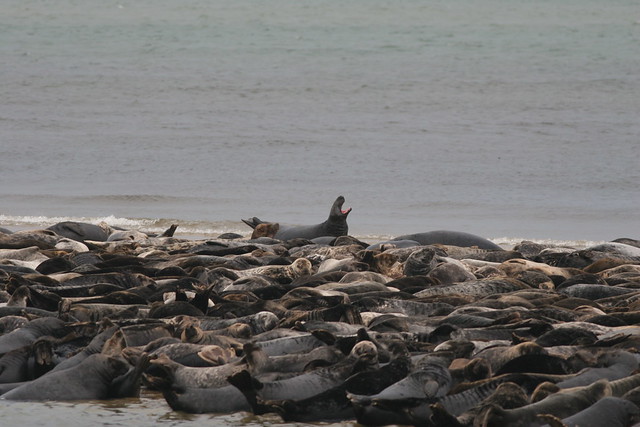 ROCKLAND, Maine — Decades after gray seals were all but wiped out in New England waters, the population has rebounded so much that some frustrated residents are calling for a controlled hunt. Read more here 12:56
ROCKLAND, Maine — Decades after gray seals were all but wiped out in New England waters, the population has rebounded so much that some frustrated residents are calling for a controlled hunt. Read more here 12:56
Thriving in Cape Cod’s Waters, Gray Seals Draw Fans and Foes

A survey in 1994 spotted 2,035 seals in Cape Cod waters. In 2011, surveyors counted more than 15,700, according to the National Marine Fisheries Service. Some scientists suggest the number of gray seals in United States waters may now be at its highest point in history. more@nyt
Seal tagging will be a first on East Coast
Researchers hope to place tags on seven gray seals this week off Chatham and Wellfleet. It will be the first such tagging on adult gray seals in U.S. Atlantic waters, and scientists hope it will answer many of the questions they share with local residents and fishermen about these large marine mammals. Waring hopes the tagging data will begin to answer questions such as where adult seals go when they leave the beach, how deep they dive, what they feed on and whether they are shuttling back and forth between the large Canadian seal colonies off Nova Scotia or north in the St. Lawrence River. continued @ capecodtimes
Forecast for Cape seals: Lots of gray
CHATHAM — On a recent fishing trip around Monomoy Island, Orleans fisherman Bill Amaru and his crew counted 4,000 gray seals that had hauled out on the island’s sandy beaches. While the experts still don’t know
![]() the exact number of gray seals in our waters, the latest stock assessment from the National Marine Fisheries Service estimated gray seals on the Cape and Islands at 15,756 in 2011 as compared with 5,611 in 1999. On one day in April 2011, researchers counted more than 10,000 seals hauled out on Monomoy alone. continue reading
the exact number of gray seals in our waters, the latest stock assessment from the National Marine Fisheries Service estimated gray seals on the Cape and Islands at 15,756 in 2011 as compared with 5,611 in 1999. On one day in April 2011, researchers counted more than 10,000 seals hauled out on Monomoy alone. continue reading


































